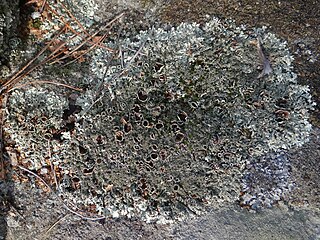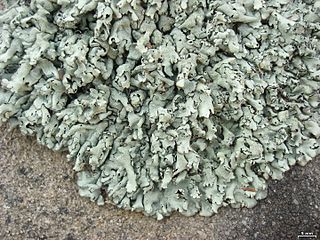
A depside is a type of polyphenolic compound composed of two or more monocyclic aromatic units linked by an ester group. Depsides are most often found in lichens, but have also been isolated from higher plants, including species of the Ericaceae, Lamiaceae, Papaveraceae and Myrtaceae.

Xanthoparmelia is a genus of foliose lichen in the family Parmeliaceae. Xanthoparmelia is synonymous with Almbornia, Neofuscelia, Chondropsis, Namakwa, Paraparmelia, and Xanthomaculina. This genus of lichen is commonly found in the United States, as well as Australia, New Zealand and Ecuador.
Psiloparmelia is a genus of lichen belonging to the family Parmeliaceae. It contains 13 Southern Hemisphere species, most of which are found growing on rocks at high elevations in South America. There are several characteristic features of the genus that are used to distinguish it from the morphologically similar genera, such as Arctoparmelia, Flavoparmelia, and Xanthoparmelia. These include a dark, velvety lower thallus surface that usually lacks rhizines, a negative test for lichenan, and a high concentration of usnic acid and atranorin in the cortex.
Xanthoparmelia pokornyi is a lichen species in the family Parmeliaceae. It contains the depsides gyrophoric acid and stenosporic acid.

Xanthoparmelia mougeotii is a species of foliose lichen belonging to the family Parmeliaceae.

Xanthoparmelia conspersa, commonly known as the peppered rock-shield, is a foliose lichen and the type species of genus Xanthoparmelia. It is widely distributed in temperate zones, and has been recorded from Japan, Europe, Africa, North America, and South America.

Lecanoric acid is a chemical produced by several species of lichen. Lecanoric acid is classified as a polyphenol and a didepside and it functions as an antioxidant. The acid is named after the lichen Lecanora. The acid has also been isolated from Usnea subvacata, Parmotrema stuppuem, Parmotrema tinctorum,Parmotrema grayana, Xanthoparmelia arida and Xanthoparmelia lecanorica. A related compound, 5-chlorolecanoric acid, is found in some species of Punctelia.

Xanthoparmelia lineola, commonly known as the tight rock-shield, is a foliose lichen species in the genus Xanthoparmelia. It is a common species with a temperate distribution. Found in North America and South Africa, it grows on rocks.

Constipatic acid is a fatty acid found in several lichen species. It was isolated, identified, and named by Douglas Chester and John Alan Elix in a 1979 publication. The compound was extracted from the Australian leafy lichen called Xanthoparmelia constipata, which was collected on schist boulders west of Springton, South Australia. The related compounds protoconstipatic acid and dehydroconstipatic acid were also reported concurrently. Syo Kurokawa and Rex Filson had previously detected the compounds using thin-layer chromatography when they formally described the lichen as a new species in 1975, but had not characterised them chemically.

Xanthoparmelia cumberlandia is a lichen which belongs to the Xanthoparmelia genus. It is also known as a member of the rockfrong lichens due to its coloration.
Xanthoparmelia lobuliferella is a species of saxicolous (rock-dwelling), foliose lichen in the family Parmeliaceae. Found in South Africa, it was formally described as a new species in 2002 by Australian lichenologist John Elix. The type specimen was collected from the Jonaskop mountain at an altitude of 1,600 m (5,200 ft); there it was found growing on south-facing rocks. It contains several lichen products: major amounts of usnic acid and stictic acid, and minor amounts of constictic acid, norstictic acid, cryptostictic acid, lobaric acid, stenosporonic acid, lichesterinic acid, and protolichesterinic acid. The species epithet refers to its resemblance to Xanthoparmelia lobulifera.
Xanthoparmelia malawiensis is a species of saxicolous (rock-dwelling), foliose lichen in the family Parmeliaceae. Found in Malawi, it was formally described as a new species in 2002 by Australian lichenologist John Elix. The type specimen was collected in Nyika National Park at an altitude of 2,300 m (7,500 ft), where it was found growing on granite rocks. It is only known from the type locality. It contains usnic acid and stictic acid as major lichen products, and minor amounts of constictic acid, norstictic acid, cryptostictic acid, and lusitanic acid.
Xanthoparmelia perezdepazii is a species of saxicolous (rock-dwelling), foliose lichen in the family Parmeliaceae. It is found in the Canary Islands.

Constictic acid is a chemical compound of the depsidone class. It was first isolated in 1968 from lichen of the genus Usnea. It has since been found in many other lichen genera including Menegazzia, Crespoa, and Xanthoparmelia.

Xanthoparmelia plittii is a lichen which belongs to the Xanthoparmelia genus.

Xanthoparmelia angustiphylla is a foliose lichen that belongs to the genus Xanthoparmelia.

Xanthoparmelia ajoensis is a foliose lichen that belongs to the genus Xanthoparmelia. The lichen is uncommon and is listed as vulnerable by the Nature Conservatory.
Xanthoparmelia lecanorica is a foliose lichen that belongs to the genus Xanthoparmelia. It is noted for being similar in appearance and has often been misidentified as Xanthoparmelia arida.
Xanthoparmelia callifolioides is a foliose lichen that belongs to the genus Xanthoparmelia.
Xanthoparmelia montanensis is a lichen which belongs to the Xanthoparmelia genus, it is also known as the Montana Rock-shield Lichen.












